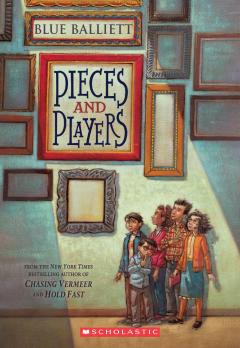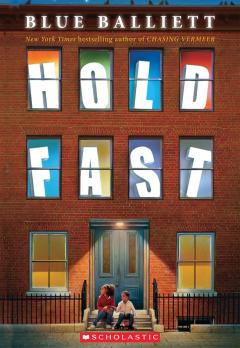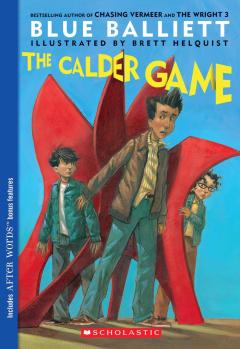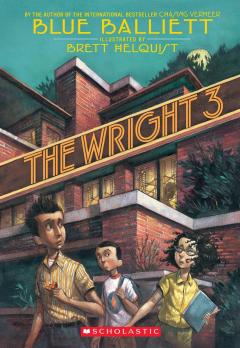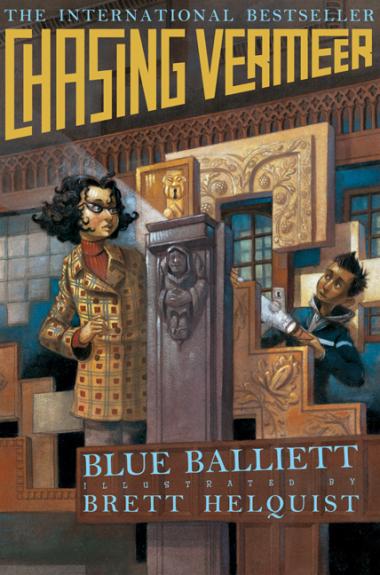
Chasing Vermeer
Illustrated By Brett Helquist
About this book
When a book of unexplainable occurances brings Petra Andalee & Calder Pillay together, strange things start to happen: seemingly unrelated events connect, an eccentric old woman seeks their company, & an invaluable Vermeer painting disappears. Before they know it, the two find themselves at the center of an international art scandal. As Petra & Calder are drawn clue by clue into a mysterious labyrinth they must draw on their powers of intuition, their skills at problem solving, and their knowledge of Vermeer. Can they decipher a crime that has left even the FBI baffled?Reviews
Voice of Youth AdvocatesDecember 1, 2004
Mix classic artworks with crime? It seems to be a popular plot that makes its way here to a thriller for young readers. Two eccentric sixth graders at the University School find themselves in the middle of a major art theft. Who was Vermeer? What does Charles Fort have to do with it all? (He was real.) And why do Petra and Calder get clues about what has happened? Petra sees images that relate to the picture of the lady, and Calder's favorite game pieces, from pentominoes, give him clues. Their teacher, Miss Hussey, seems to be involved, as does elderly Mrs. Sharpe, and perhaps Calder's father. And then there is something odd about Mr. Watch from Powell's Bookstore. Calder's friend Tommy sends coded messages and then goes missing. Plenty of clues, wrong directions, speculation, and good guesses lead Petra and Calder on a sequence of adventures to find the art work before it is destroyed. This exciting romp will appeal to middle school readers and make them think about clues and even art. The adults are given good characterizations although the young people do not know whom to trust and perhaps get in a little deeper than they should. The ending comes a bit too quickly without enough evolution and there are a number of loose ends, but most readers will overlook this flaw for the fun. The illustrations by Helquist, of Lemony Snicket fame, contain hidden messages that present challenging puzzles to the reader.-Patricia Morrow.
Horn Book Magazine
July 1, 2004
(Intermediate) "Dear Friend: I would like your help in identifying a crime that is now centuries old." Sixth-grade classmates Petra Andalee and Calder Pillay are drawn into the mystery: a claim that some of the works attributed to Johannes Vermeer were not, in fact, painted by that seventeenth-century Dutch artist. Their investigation--fueled by the enigmatic behavior of their favorite teacher, a shared interest in unexplained phenomena, and a few mystical experiences of their own--uncovers a series of coincidences and connections that, like the pentomino set (a puzzle-like math tool) Calder carries in his pocket, fit together in often-unexpected patterns. And when Vermeer's A Lady Writing disappears while in transit from the National Gallery to the Art Institute of Chicago, Petra and Calder end up hunting for the missing painting right in their own neighborhood. The protagonists are smart and appealing, the prose style is agreeably quirky, and fans of puzzle-mysteries will enjoy cracking the codes presented within the text and hidden in Helquist's stylish black-and-white illustrations. But they may also be frustrated that such a heady, elaborately plotted novel comes to a weak resolution, as the answers to the mysteries are explained away in a too-hasty summation--and the villain turns out to be an offstage figure. The conclusion may be disappointing, but the chase to the end is entertaining. Copyright 2004 of The Horn Book, Inc. All rights reserved.
School Library Journal
July 1, 2004
Gr 5-8-Fans of Ellen Raskin's The Westing Game (Dutton, 1978) and E. L. Konigsburg's From the Mixed-Up Files of Mrs. Basil E. Frankweiler (Turtleback, 1967) will welcome this novel about two classmates determined to solve the mystery of a missing painting. Brainy 12-year-olds Petra Andalee and Calder Pillay attend the University of Chicago Laboratory School where their teacher's unorthodox methods make learning an adventure. When Vermeer's A Lady Writing disappears on its way to exhibition at the Art Institute of Chicago, the two overcome their adolescent awkwardness and let their friendship bloom, pooling their talents to rescue the masterpiece and expose the thief. Many elements play a role in unraveling the secrets surrounding the crime: Calder's set of pentominoes; his encoded correspondence with his friend Tommy about a missing boy named Frog; and Petra's intuitive communing with the woman in the painting, all augmented by the unusual ideas presented in a strange old book that Petra has found. Balliett also provides lots of plot twists and red herrings along the way. Helquist's atmospheric black-and-white illustrations add to the fun, incorporating clues to a secret message, the answer to which can be found on the publisher's Web site. Puzzles, codes, letters, number and wordplay, a bit of danger, a vivid sense of place, and a wealth of quirky characters enrich the exciting, fast-paced story that's sure to be relished by mystery lovers.-Marie Orlando, Suffolk Cooperative Library System, Bellport, NY Copyright 2004 Reed Business Information.
Publishers Weekly
June 14, 2004
Puzzles nest within puzzles in this ingeniously plotted and lightly delivered first novel that, revolving around the heist of a Vermeer painting, also touches on the nature of coincidence, truth, art and similarly meaty topics. Petra Andalee and Calder Pillay become friends in sixth grade at a school operated by the University of Chicago (Balliett taught at the University's Lab Schools), both of them independent thinkers excited by their maverick teacher, Ms. Hussey. For reasons unknown to her students, the teacher asks her class to ponder the importance of letters (the epistolary sort) and to mull over Picasso's ideas about art as "a lie that tells the truth." Readers have the edge on the characters, being privy to an enigmatic letter sent to three unidentified persons outlining a centuries-old "crime" against a painter's artistic legacy. These mysteries deepen exponentially when someone steals a Vermeer masterpiece and holds it hostage, demanding scholarly redress for misattributions within Vermeer's small oeuvre. The art mystery and the crisp intelligence of the prose immediately recall E.L. Konigsburg, but Balliett is an original: her protagonists also receive clues through dreams, pentominoes (math tools with alphabetic correspondences), secret codes (including some left to readers to decipher) and other deliberately non-rational devices. Helquist (the Lemony Snicket books) compounds the fun with drawings that incorporate the pentomino idea to supply visual clues as well. Thick with devilish red herrings, this smart, playful story never stops challenging (and exhilarating) the audience. Ages 8-12. (June) Copyright 2004 Reed Business Information.
Booklist
April 1, 2004
Gr. 5-8. The Westing Game, The Mixed-Up Files of Mrs. Basil E. Frankweiler--how exciting to find a book that conjures up these innovative, well-loved titles. That's exactly what Balliett does in her debut novel, which mixes mystery, puzzles, possibilities, and art. The story is set in Chicago's Hyde Park neighborhood at the University of Chicago's Lab School, where Balliett was a teacher. There, outsiders Petra and Calder become friends as they try to find out what happened to a missing Vermeer painting. That's really all the plot one needs to know. More important are Balliett's purpose in writing and the way she has structured her story. The former seems to be to get to children to think--about relationships, connections, coincidences, and the subtle language of artwork. To accomplish this, she peppers her story with seemingly random events that eventually come together in a startling, delightful pattern. The novel isn't perfect. It glides over a few nitty-gritty details (how did the thief nab the picture), and occasionally the coincidences seem more silly than serendipitous. However, these are quibbles for a book that offers children something new upon each reading. Adults who understand the links between children's reading and their developing minds and imaginations will see this as special, too. Helquist, who has illustrated the Lemony Snickett books, outdoes himself here, providing an interactive mystery in his pictures. --Ilene Cooper Copyright 2004 Booklist

